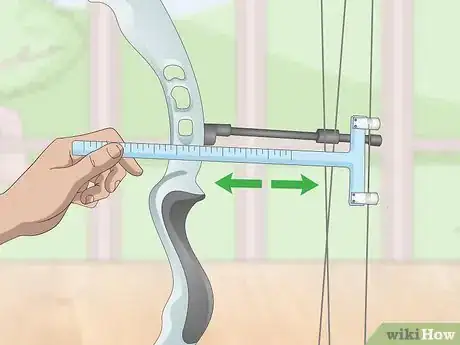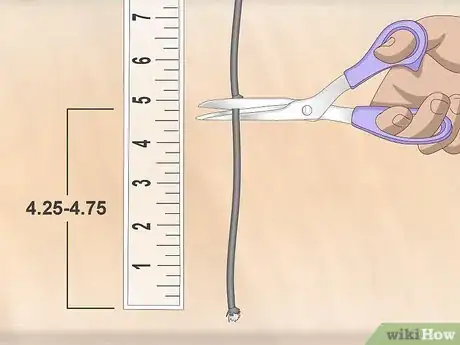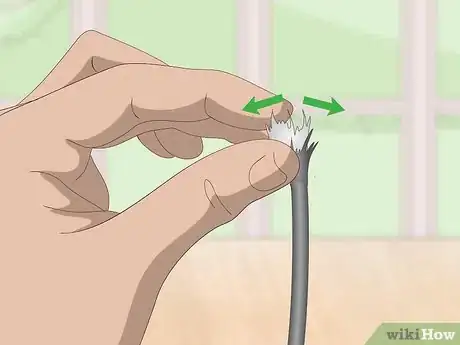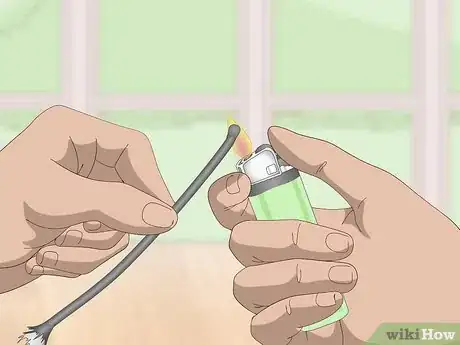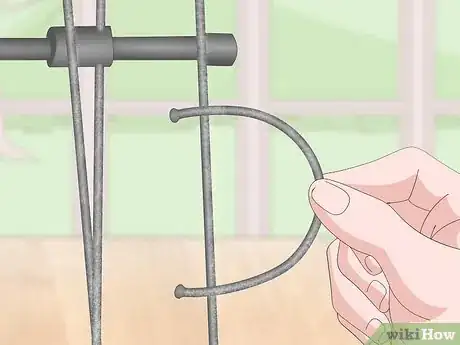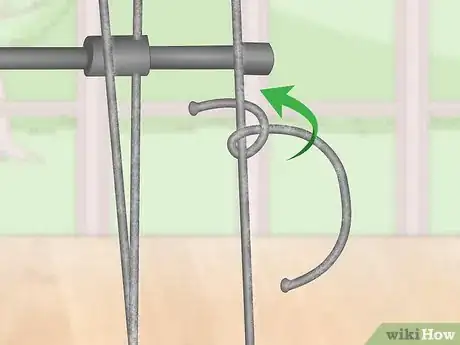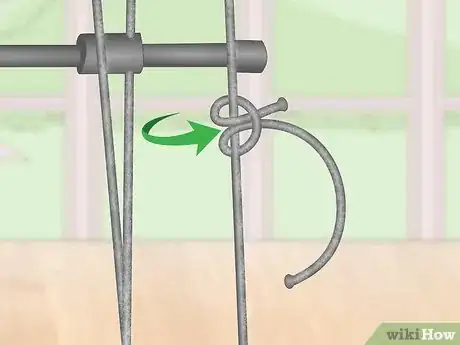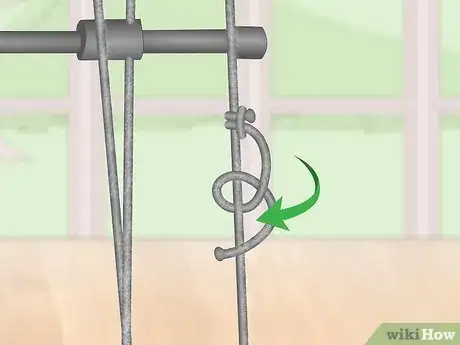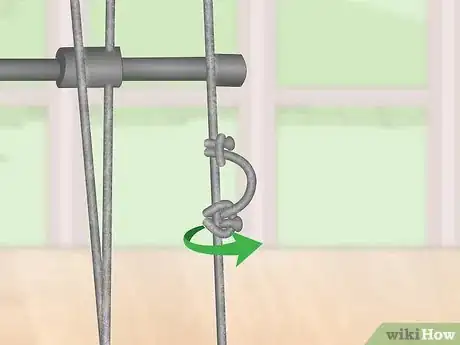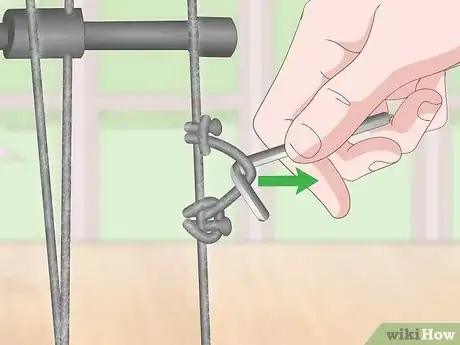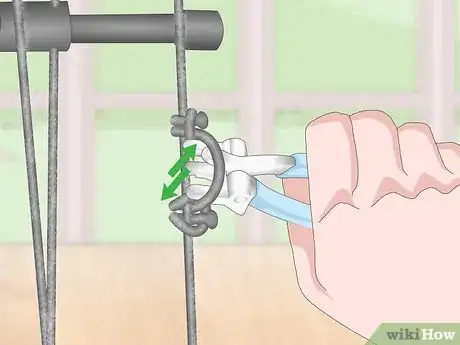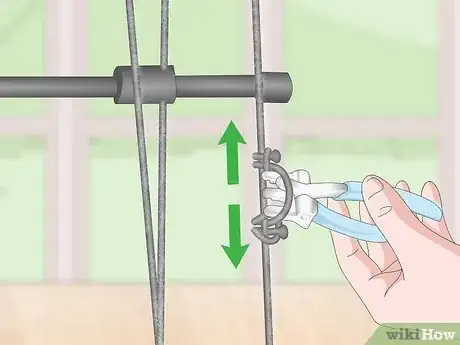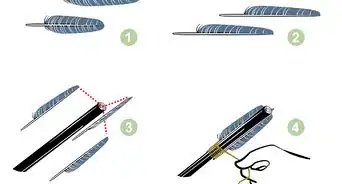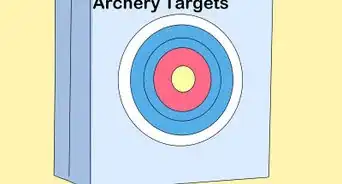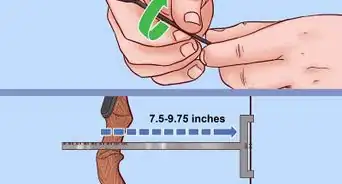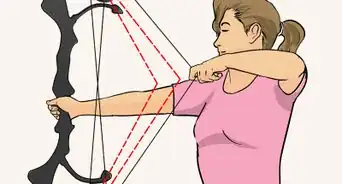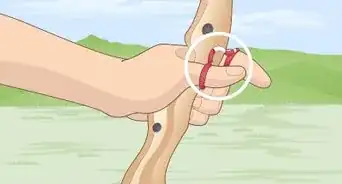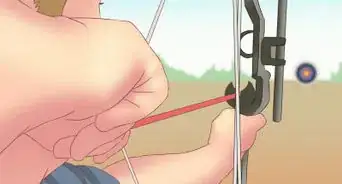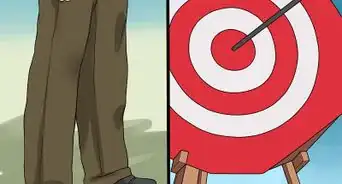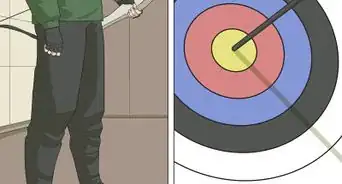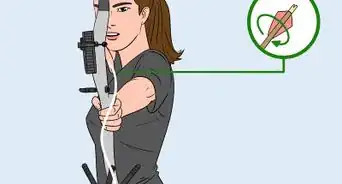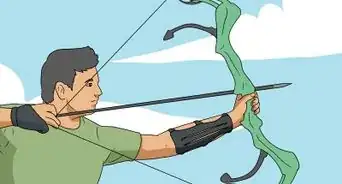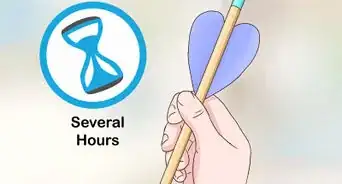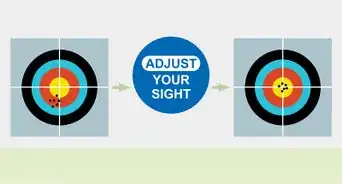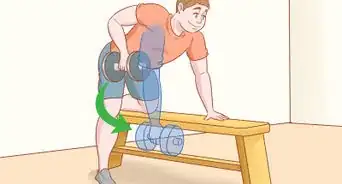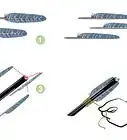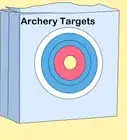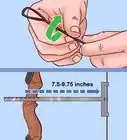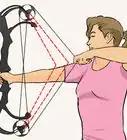This article was co-authored by wikiHow Staff. Our trained team of editors and researchers validate articles for accuracy and comprehensiveness. wikiHow's Content Management Team carefully monitors the work from our editorial staff to ensure that each article is backed by trusted research and meets our high quality standards.
There are 10 references cited in this article, which can be found at the bottom of the page.
This article has been viewed 28,152 times.
Learn more...
A D-loop is a type of device that is commonly installed on the strings of compound bows to allow archers to quickly and easily attach mechanical release aids. To tie a D-loop for your bow, start by trimming your D-loop cord to a length of about 4.25 inches (10.8 cm). Fan out the cut ends and wave the flame of a lighter over them to harden them into a ball shape. Tie a loose cinch knot on either end of your nock, then use a hex key and a pair of D-loop pliers to tighten both knots until they’re nice and secure.
Steps
Cutting the Cord
-
1Use a bow square to find your ideal tie-in location. Clip the “T”-shaped end of the bow square to your bowstring. Slide the square along the string little by little until the ruled end is aligned with the dead center of the Berger hole. Mark the spot with a felt-tipped marker or sliver of tape—this will be your nock.[1]
- If you don't already have a bow square, you can pick one up from an archery supply store or sporting goods shop that carries archery equipment.
- The Berger hole is the small drilled hole on the outside of the bow frame where the arrow rest attaches. It is centered to ensure that the arrow nocks correctly and flies true when released.[2]
Tip: Some archers recommend setting the nock about 1⁄8 in (0.32 cm) higher than the Berger hole to account for movement in the shaft of the arrow.
-
2Trim a length of D-loop cord to about 4.25–4.75 inches (10.8–12.1 cm). Measure your cord with the aid of a ruler, then use a pair of sharp scissors to snip both ends. Do your best to make your cuts as straight and precise as possible.[3]
- You can buy D-loop cord from any sporting goods store or online vendor that carries archery supplies.
- If your cord is any shorter than 4 inches (10 cm), there may not be enough room inside the finished loop to comfortably accommodate a mechanical release aid.[4]
Advertisement -
3Fan out the fibers on the cut ends of the cord. To do this, you can either spread the fibers manually with your fingers or twirl the end of the cord against a smooth, flat surface. What’s important is that the fibers flare out uniformly on all sides.[5]
- Avoid expanding the fibers so much that they point straight out to the sides. If they’re spread too wide, they may become thin and brittle once you burn them.
-
4Burn the splayed cord ends with a lighter. Wave the flame of your lighter over the cord ends for 1-2 seconds, just long enough to cause them to melt into a smooth, rounded shape. This type of ball end style is known as a “mushroom.”[6]
- You can also create a mushroom by heating the cord ends before quickly pressing them into a nearby flat surface, such as the housing of your lighter.[7]
- The mushrooms will prevent the end of the cord from slipping out of the cinch knots you’ll be tying later.
Tying the Cinch Knots
-
1Bend the cord into a “D”-shape just above the center of your string. Lay the cord across the topside of the bowstring roughly 1⁄2 inch (1.3 cm) higher than the nock. Make sure the curved section is facing away from the riser, or the central “body” of the bow.[8]
- At this point, both ends of the cord should still be approximately the same length.[9]
- The nock is the spot along the bowstring where you’ll fit the end of the arrow.
-
2Wind the ends of the cord around the string and through the open loop. Wrap both ends down around the bowstring and up through the circular loop from the bottom. You’ll end up with a shape that looks like a “B” with the two cord ends running through the middle.[10]
- You may need to apply pressure to the curved section of the cord with one finger to keep it from coming out of place while you feed the ends through.
-
3Pull one end of the cord until the mushroom catches in the knot. Take hold the end closest to the bottom of the bow and continue pulling it through the loop slowly. This will cause the other end to choke up on the knot, but it won’t slip through thanks to the mushroom.[11]
- When you’re satisfied that the mushroom isn’t going anywhere, tug the loose end of the cord a few times to get your first cinch knot snug and secure.[12]
Tip: Pinch the edges of the cord toward one another to condense the knot and guarantee that there’s not enough space for the mushroom to pull free.
-
4Wrap the loose end around the bowstring below the nock. Guide the cord to the opposite side of the nock, again roughly 1⁄2 inch (1.3 cm) from the center. Loop the cord over the topside of the string, down underneath, then back up on the nock side.[13]
- This initial wrap will create the first anchor point for your second cinch knot.
- It’s essential that the mushroom end up on the same side of the cord you started from. If you wrap the cord in a normal spiral fashion towards the bottom of the bow, it won’t be in the right position to tie the second cinch knot.
-
5Loop the loose end around the string and back through the center loop. Pull the cord across the first knot anchor, then wrap it around the bowstring again. This time, guide the end underneath the bottom of the string and back towards the first knot. Then, push the end through the loop to complete the second knot.[14]
- When you pull the slack out of the curved portion of the cord, the mushroom will catch, securing the knot on both ends.
- If you tied them correctly, your two cinch knots should mirror one another, with the mushrooms facing opposite directions on either side of the nock.[15]
Tightening and Adjusting the D-loop
-
1Tighten your D-loop with a hex wrench. Slide the shaft of the hex wrench into the finished loop and pull up on it sharply. This will stretch the loop to its maximum size, making it possible to fit your mechanical release aid of choice inside and enable more accurate shooting.[16]
- Try to get the cinch knots as firm as you can before you move onto the final tightening.
- If you’re not sure whether the loop is big enough, perform a quick test by clipping a plastic nock to the string between the two cinch knots. One of these will be roughly the same size as a release.
-
2Use a pair of D-loop pliers to take any remaining slack out of the knots. Insert the tip of the pliers into the loop, then open them wide. Really crank on the handles until the loop won’t budge anymore. The tighter the loop, the less chance that something will go wrong and sabotage your shot.[17]
- You can also use a standard set of needle-nose pliers if you don’t happen to have any archery-specific pliers lying around.[18]
Tip: One benefit of using D-loop pliers is that they’re designed with a special groove that cradles the cord while you tighten, making it less likely to slip off or come undone.
-
3Install your mechanical release aid of choice. Once you've successfully tied your D-loop, you can go on to attach an index finger, thumb trigger, hinge, or resistance release to enhance your speed and precision. Most of these devices simply clip onto the backside of a bowstring or D-loop, similar to a carabiner.[19] Image:Tie a D‐Loop Step 12.jpg
- Release aids cut down on interference from the fingers during release, making each shot as smooth, clean, and accurate as possible.
- If you're new to archery, take some time to research and experiment with different release styles and see which one works best for you.[20]
-
4Alter the position of the D-loop if necessary. If you discover that your aim is off after taking your bow out for a spin, it could be because your D-loop isn’t properly centered over the nock. In this case, all it takes is a little pressure from your pliers to nudge the cinch knots over to where they need to be.
- If you still have issues after adjusting the D-loop, it may be necessary to re-nock your string using a bow square. Take your time and line up the nocking point as precisely as possible.
Warnings
- Be careful not to accidentally burn yourself or your damage your D-loop cord when melting the ends.⧼thumbs_response⧽
- Unless you have some experience rigging your own archery accessories, it may be a good idea to have a qualified bow specialist go over how to tie a D-loop with you. Seeing it done the first time will help ensure that you know how to do it correctly yourself in the future.⧼thumbs_response⧽
Things You’ll Need
- Compound bow
- D-loop cord
- D-loop or needle-nose pliers
- Lighter
- Scissors
- Bow square (optional)
References
- ↑ https://shootingtime.com/archery/installing-d-loop/
- ↑ http://thebestcompoundbows.com/compound-bows-parts-functions/
- ↑ http://archeryreport.com/2011/12/how-to-make-install-d-loop/
- ↑ https://shootingtime.com/archery/installing-d-loop/
- ↑ https://www.youtube.com/watch?v=d5066APlmGk&feature=youtu.be&t=22
- ↑ https://www.bowhunting.com/bowhunt101/how-to-tie-a-d-loop/
- ↑ https://worldarchery.org/news/146265/archery-101-how-tie-d-loop
- ↑ https://www.youtube.com/watch?v=d5066APlmGk&feature=youtu.be&t=60
- ↑ https://worldarchery.org/news/146265/archery-101-how-tie-d-loop
- ↑ https://www.bowhunting.com/bowhunt101/how-to-tie-a-d-loop/
- ↑ https://shootingtime.com/archery/installing-d-loop/
- ↑ https://www.youtube.com/watch?v=d5066APlmGk&feature=youtu.be&t=96
- ↑ https://worldarchery.org/news/146265/archery-101-how-tie-d-loop
- ↑ https://shootingtime.com/archery/installing-d-loop/
- ↑ http://archeryreport.com/2011/12/how-to-make-install-d-loop/
- ↑ https://worldarchery.org/news/146265/archery-101-how-tie-d-loop
- ↑ https://www.bowhunting.com/bowhunt101/how-to-tie-a-d-loop/
- ↑ http://archeryreport.com/2011/12/how-to-make-install-d-loop/
- ↑ https://www.youtube.com/watch?v=Lk32tXffSyw&feature=youtu.be&t=11
- ↑ https://www.archery360.com/2017/05/24/release-aids-101-one-right/
